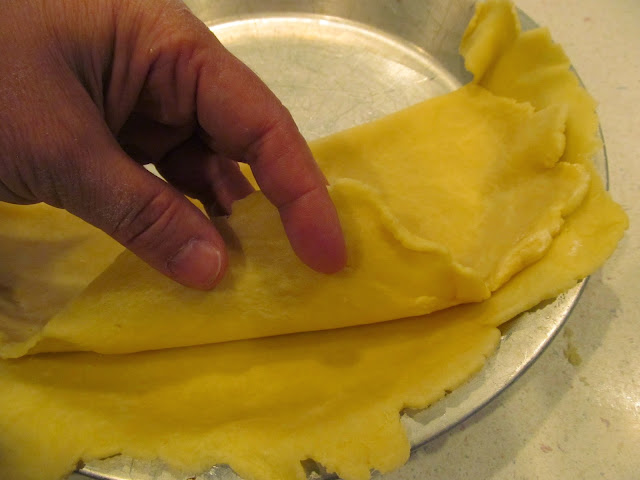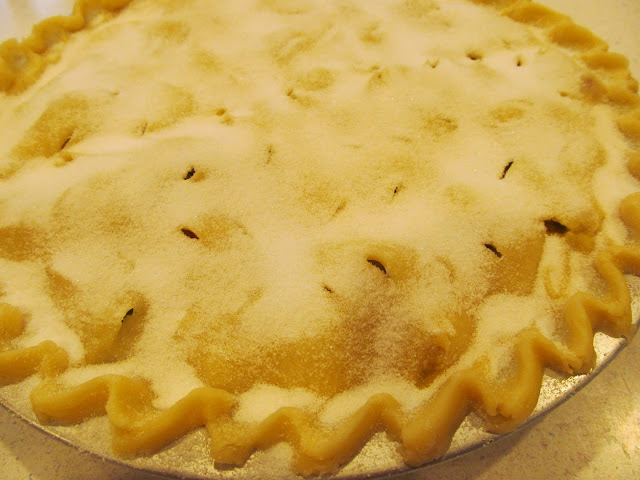So what is this story leading up to? Well Rhubarb of course. More specifically, Rhubarb Pie. And to be even more direct, the best Rhubarb Pie known to man, my Grandma's Rhubarb Pie. In honor of her birthday, which just happens to be this week, and also my friend, LaDawna, who generously supplies the main ingredient for my yearly craving, this week's featured recipe is Grandma's Rhubarb Pie. Now I know there are many variations of this dessert, including the addition of strawberries, but to my family there is only one way to eat rhubarb, and this is it. Grandma's recipe combines the tart, fresh rhubarb with (lots of) sugar, eggs, and tapioca, resulting in a sweet, custard-like filling that I have never seen duplicated. I'm not so sure Grandma didn't create it herself! Regardless of the recipe's true origin, trust me when I say that if you have never liked rhubarb before, this may just be the dish that turns you around for life. Give it a try! See instructions for the filling, and for my easy, flaky crust at the end of today's post.
By the way, if I haven't convinced you already, according to my research Rhubarb can be beneficial to aid weight loss (well, maybe not in pie form!) improve digestion, prevent Alzeheimer's disease, stimulate bone growth, increase skin health, prevent cancer, optimize metabolism, improve circulation, and protect against various cardiovascular conditions. Rhubarb is packed with minerals, vitamins, dietary fiber, protein, Vitamin C, Vitamin K, Calcium Potassium, and Magnesium.
Grandma’s
Rhubarb Pie
One
batch makes a large pie, and a double batch makes 2 large pies. I always make one for now and one to freeze
for later.
4 to 5 good full
cups of sliced Rhubarb
1 3/4 cups Sugar
1 teaspoon Salt
3 level Tablespoons Flour
2 Tablespoons Minute Tapioca
3 large Eggs
Pastry for a 2-crust Pie (see recipe below)
-Remove leaves from rhubarb and discard. Wash well and slice. Measure into a large bowl.
1 teaspoon Salt
3 level Tablespoons Flour
2 Tablespoons Minute Tapioca
3 large Eggs
Pastry for a 2-crust Pie (see recipe below)
-Remove leaves from rhubarb and discard. Wash well and slice. Measure into a large bowl.

 -Mix up the sugar,
salt, and flour. Pour this over 4-5 good
full cups sliced Rhubarb, mix well, and let sit while you mix up your crust—at least
a half hour.
-Mix up the sugar,
salt, and flour. Pour this over 4-5 good
full cups sliced Rhubarb, mix well, and let sit while you mix up your crust—at least
a half hour.

 -Roll out and place
bottom crust (see recipe below or use your own) into large pie plate.
-Roll out and place
bottom crust (see recipe below or use your own) into large pie plate.  -Sprinkle bottom of
crust evenly with 2 Tablespoons Tapioca.
-Sprinkle bottom of
crust evenly with 2 Tablespoons Tapioca. -Pour Rhubarb mixture in and spread evenly.
 Sprinkle sugar
generously on crust and bake at 400 degrees for about 50 minutes or more until
nicely browned.
Sprinkle sugar
generously on crust and bake at 400 degrees for about 50 minutes or more until
nicely browned.
Favorite Pie
Crust
-In mixing bowl
place 3 cups flour, ¼ teaspoon salt, 2 Tablespoons sugar and mix together.
-With pastry
blender, cut 1 ¼ cup shortening into dry mixture until part is like cornmeal
and part is like small peas (as my Beehive teacher taught us oh so many years ago!)
 In small bowl, use
a fork to whisk 5 Tablespoons cold water with 1 Tablespoon Vinegar and 1 large egg.
In small bowl, use
a fork to whisk 5 Tablespoons cold water with 1 Tablespoon Vinegar and 1 large egg.  Pour this into
flour/shortening mix and stir quickly with fork until it comes together, then
form gently into a ball.
Pour this into
flour/shortening mix and stir quickly with fork until it comes together, then
form gently into a ball.  If you want to
make 2 double crust pies, divide the ball of dough into 4 pieces, with 2 being
the same size as each other and the other two also being the same size as each
other, only about ¼ smaller than the first two.
This is because the larger two will be for the bottom crusts, and the smaller
two will be for the top crusts.
If you want to
make 2 double crust pies, divide the ball of dough into 4 pieces, with 2 being
the same size as each other and the other two also being the same size as each
other, only about ¼ smaller than the first two.
This is because the larger two will be for the bottom crusts, and the smaller
two will be for the top crusts.This only shows me using one hand (even though you need to use both hands) because I was taking the photo with the other hand!
Sprinkle with sugar and bake according to recipe instructions for the type of pie you are making.




































No comments :
Post a Comment